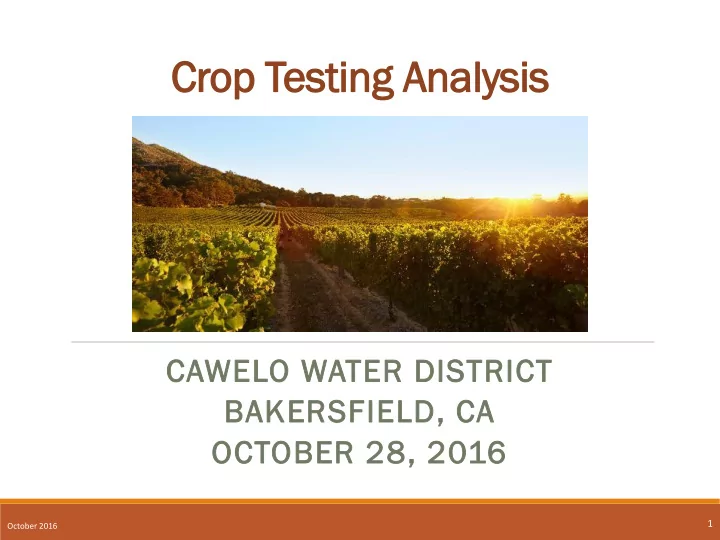

Crop Testing Analysis CAWELO WATER DISTRICT BAKERSFIELD, CA OCTOBER 28, 2016 1 October 2016
Expert Engagement Ana naly lytical tical Data: a: • Amec Foster Wheeler Environmental & Infrastructure, Inc. • Advanced Environmental Concepts, Inc. • Weck Laboratories, Inc. • Anresco Laboratories Evaluati valuation: on: • Dr. Heriberto Robles, Enviro-Tox Services, Inc. 2 October 2016
Credentials Her eriber iberto o Robl bles, es, M.S. S., , Ph.D., .D., D.A.B.T .B.T.: .: • 35 years experience in environmental toxicology and human health and environmental risk assessment • Certified by the American Board of Toxicology • One of 3,125 in the world Exper ertise: tise: • Human and Occupational Toxicology • Environmental Toxicology • Human and Ecological Risk Assessment • Environmental Chemical Fate and Transport 3 October 2016
Cawelo Water District Mission sion to provide vide cl clea ean, n, safe e irr rriga gation tion water er: • Serving Kern County for more than 50 years • Provides irrigation water to 34,000 acres of orchards, vineyards and other crops • Working collaboratively with regulators to evaluate water quality • Monitored by the Central Valley Regional Water Quality Control Board (Regional Board): • Long history of compliance with the Regional Board • Monthly testing and reporting for nearly 70 constituents • Expanded quarterly testing and reporting for more than 160 constituents 4 October 2016
Decisions Based on Sound Science Thoughtf oughtful ul Di Dialogue logue Gu Guided ded by Facts: cts: Study #1 • Initial water quality testing for approximately 70 constituents & analysis of almonds, grapes and pistachios (presented April 2016) Study #2 • Testing of oranges, mandarins and lemons Study #3 • Testing of carrots and potatoes Study #4 • On June 17, 2016, the oil company submitted to the Regional Board a list of constituents used in the oil extraction process • The expanded water quality testing of more than 160 constituents, based off the oil company list, is now conducted and reported quarterly to the Regional Board 5 October 2016
Snapshot of Current Scientific Facts Ini niti tial al Res esults ults Sh Show Rec ecycled cled Produced oduced Water er Supply Su ply Sa Safe e for r Irr rrigation: igation: • Water quality testing for nearly 70 constituents presented to the Food Safety Panel in April 2016 • Meets water quality goals for agricultural use • Organic compounds either at or below levels considered safe for drinking water (a higher standard than what is required for agricultural use) • U.S. EPA Regional Screening Levels for tap water • Cal/EPA Environmental Screening Levels 6 October 2016
Snapshot of Current Scientific Facts Alm lmonds nds, , Gra rapes pes & Pis istachios: tachios: • Analysis supports initial water quality findings; water safe for agriculture irrigation • Testing showed crops irrigated with produced water have a similar chemical composition as foods grown with any other water supply 7 October 2016
New Citrus Crop Analysis Mandar ndarin ins, s, Ora rang nges es & Le Lemo mons: ns: • Analysis supports initial water quality findings; water safe for agriculture irrigation • Utilized U.S. EPA testing protocols • Nine constituents identified from water quality study • Tested for: acetone, benzene, toluene, ethylbenzene, xylenes, acenaphthene, fluorene, naphthalene and phenanthrene 8 October 2016
New Citrus Crop Analysis Mandar ndarin ins, s, Ora rang nges es & Le Lemo mons: ns: • Nine constituents either not found or found at similar concentrations in both Test and Control samples • Results indicate organic constituents are not being absorbed nor accumulated in edible fruit • Test and Control samples collected from eighteen different sampling locations on Feb. 16 and 17, 2016 • Re-test date March 23, 2016, fruit and dust samples • Ongoing testing recommended 9 October 2016
New Root Crop Analysis Summary Carr rrots ts & Potat atoes: oes: • Analysis supports initial water quality findings; water safe for agriculture irrigation • Acetone detected in Test and Control samples at extremely low levels, indicating it is a naturally occurring substance • Preliminary results show organic constituents are not being absorbed nor accumulated in the roots of plants • Nine constituents identified from water quality study • Tested for: acetone, benzene, toluene, ethylbenzene, xylenes, acenaphthene, fluorene, naphthalene and phenanthrene • Final report expected to be released in November 2016 10 October 2016
Expanded Water Quality Testing Qua uarterly erly Tes esti ting ng for r 160+ + Consti nstitue tuents: nts: • On June 17, 2016, the oil company submitted to the Regional Board a list of constituents used in the oil extraction process • In August 2016, Cawelo submitted expanded water quality data, as required by the Regional Board to test for more than 160 constituents • Systematically moving through review process of expanded testing data • To date, vast majority have been non-detectable or below drinking water quality standards – an even higher standard than required • Expanded testing 11 October 2016
Expanded Water Quality Testing Qua uarterly erly Tes esting ting for r 160+ + Consti nstitue tuents: nts: Does� Maximum� Note:� June� and� September� Detected� MCLs=Maximum� contaminant� levels� 2016� Maximum� Concentration� Detected� Compounds� Ug/L=Micrograms� per� liter� Detected� Exceed� Drinking� Concentration� (ug/L)� Water� Screening� Levels� or� MCLs?� Volatile� Organic� Compounds� � � � � 1,2,4-Trimethylbenzene� 2.4� No� 1,2-Dichloropropane� 0.19� No� Chloroform� 0.21� No� Ethylbenzene� 0.65� No� Methanol� 860� No� n-Propylbenzene� 0.23� No� Toluene� 0.42� No� Xylenes� 2.3� No� Semi� Volatile� Organic� � � � � Compounds� Acenaphthene� 0.53� No� Fluorene� 0.37� No� Naphthalene� 0.11� No� Phenanthrene� 0.22� No� Petroleum� Hydrocarbons� � � � � Kerosene� 620� No� � 12 October 2016
Next Steps Coll llaboration aboration with h Reg egional onal Board: • All data available on website • Ongoing voluntary crop sampling continues 13 October 2016
Recommend
More recommend